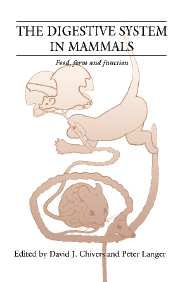Book contents
- Frontmatter
- Contents
- List of contributors
- Preface
- Part I Introduction
- Part II Food
- 5 Foods and the digestive system
- 6 Classification of foods for comparative analysis of the gastro-intestinal tract
- 7 The ‘carnivorous’ herbivores
- 8 Nutritional ecology of fruit-eating and flower-visiting birds and bats
- 9 Herbivory and niche partitioning
- 10 Taste discrimination and diet differentiation among New World primates
- 11 Potential hominid plant foods from woody species in semi-arid versus sub-humid sub-tropical Africa
- Part III Form
- Part IV Function
- Part V Synthesis and perspectives
- Index
7 - The ‘carnivorous’ herbivores
Published online by Cambridge University Press: 18 March 2010
- Frontmatter
- Contents
- List of contributors
- Preface
- Part I Introduction
- Part II Food
- 5 Foods and the digestive system
- 6 Classification of foods for comparative analysis of the gastro-intestinal tract
- 7 The ‘carnivorous’ herbivores
- 8 Nutritional ecology of fruit-eating and flower-visiting birds and bats
- 9 Herbivory and niche partitioning
- 10 Taste discrimination and diet differentiation among New World primates
- 11 Potential hominid plant foods from woody species in semi-arid versus sub-humid sub-tropical Africa
- Part III Form
- Part IV Function
- Part V Synthesis and perspectives
- Index
Summary
Few mammalian neonates have the capacity to use the food of their herbivore parents readily; even precocial young are unable to cope with the quality of the components of the adult diet or to harvest them precisely (Oftedal, 1980). Altricial young have no chance at all. The maternal pre-processing of food and presentation of nutrients as milk simplifies the processes of digestion and masticatory development for the young and is advantageous to the parent in permitting her to harvest wide food resources to produce milk. The burden of milk production is frequently very heavy, particularly where seasonal conditions result in inadequate quality and quantity of food. The milk-fed young continue to receive the same quality, but not necessarily quantity, of diet but it is done at the expense of the dam's own tissues. Many mammals under such conditions rear a reduced litter and do not survive to breed again; a few animals, such as the polar bear, normally survive terminal pregnancy and lactation, without eating, solely from body reserves (Schmidt-Nielsen, 1986).
McCance and Widdowson (1964) stress the capacity of the newborn mammal to incorporate a very high proportion of milk protein into tissue despite the immaturity of tissues and systems particularly in the gut, the kidney, and in thermal regulation. They point out that in both the newborn pig and puppy, 92–94% of dietary protein is incorporated into tissue; the same is true, but to a lesser extent, for the relatively slow-growing human infant.
- Type
- Chapter
- Information
- The Digestive System in MammalsFood Form and Function, pp. 87 - 102Publisher: Cambridge University PressPrint publication year: 1994
- 7
- Cited by



